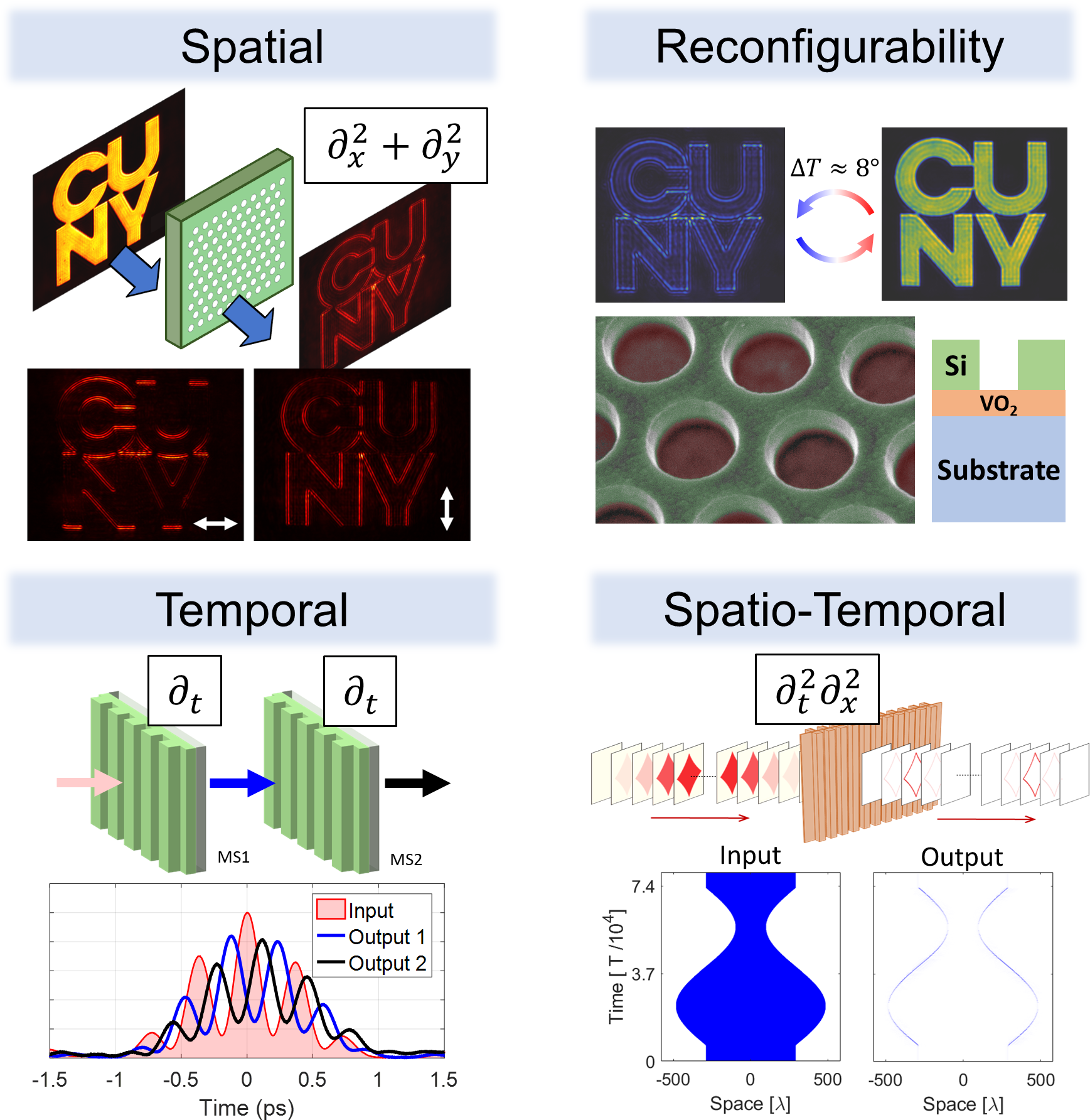Research
Our research interests span different sub-fields of metamaterials and nanophotonics. Click on the links to learn more.- Optical Metamaterials for Spatio-Temporal and Reconfigurable Analog Computation
- Nonlinear Metamaterials
- Nanoscale Control of Light Emission
- Theoretical Quantum Nanophotonics
Optical Metamaterials for Spatio-Temporal and Reconfigurable Analog Computation


All-optical computing holds the promise of increasing data rates and reducing latency and energy consumption in information processing. Metasurfaces offer an ultrathin and robust platform to accomplish these tasks in an integrated fashion. In our group, we are designing optical metasurfaces wihch perform different types of spatial, temporal and spatio-temporal analog operations on incoming wavefronts. Our approach relies on tailoring the metasurface spatial and/or temporal nonlocalities (and thus its dispersion) to synthesize the desired operations. For example, by carefully engineering the spectral position and dispersion of two distinct optical modes in a silicon photonic crystal1 we demonstrated metasurfaces performing dual-polarization edge detection for broadband spectral inputs (>5 THz at telecom wavelengths), with high numerical aperture (0.35), large throughput efficiencies, and almost perfect isotropy. The polarization-independent response1 is crucial when the illumination properties are unknown.
An important drawback of these devices is their lack of active control and reconfigurability. We proposed and demonstrated two routes to overcome this challenge. We showed that inducing and controlling large polarization asymmetries in the metasurface response - typically considered detrimental – can enable real-time reconfigurability controlled by the input polarization.2 With this strategy, we demonstrated2 metasurfaces that selectively enhance only edges oriented along the input polarization, simultaneously implementing edge detection and polarization imaging. Additionally, we demonstrated reconfigurable image-processing metasurfaces by leveraging the phase transition of phase-change materials,3 yielding devices that switch between two imaging tasks when the device temperature is changed by a few degrees.
In a parallel effort, we are extending these ideas to temporal and spatio-temporal tasks. For example, we experimentally demonstrated metasurfaces with engineered temporal nonlocalities that perform temporal differentiation on incoming optical signals, with efficiencies close to the fundamental limits imposed by passivity and causality.4 These devices are naturally prone to scalability: multiple metasurfaces, each performing an operation on the incoming wavefront, can be readily cascaded, resulting in an overall device that performs more complex operations. By simultaneously tailoring the nonlocal response in space and time, we also demonstrated passive metasurfaces that perform mixed spatio-temporal differentiation.5 This property can be used, for example, to realize event-based edge detection, whereby an object silhouette is transmitted through the metasurface only when the object moves, thus mimicking the operation of neuromorphic cameras within a passive, zero-energy analog device.
-
Dispersion engineered metasurfaces for broadband, high-NA, high-efficiency, dual-polarization analog image processing, Nature Communications 14 (1), 7078, (2023).
-
Polarization imaging and edge detection with image-processing metasurfaces, Optica 10 (10), 1331–1338, (2023).
-
Reconfigurable image processing metasurfaces with phase-change materials, Nature Communications 15 (1), 4483, (2024).
-
Temporal Signal Processing with Nonlocal Optical Metasurfaces, in press in npj Nanophotonics 1 (39), (2024).
-
Tailoring Space-Time Nonlocality for Event-Based Image Processing Metasurfaces, Phys. Rev. Lett. 133, 063801, (2024).